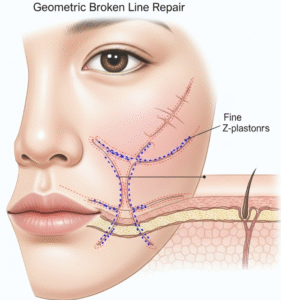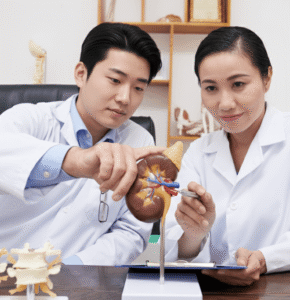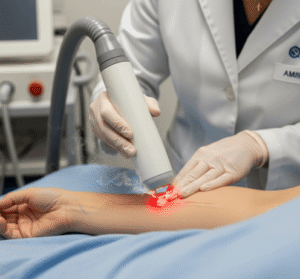What it is
A newborn physical examination is a comprehensive health assessment conducted shortly after birth to evaluate a baby’s overall health, identify congenital conditions, and detect any immediate medical concerns. This examination is an essential part of routine neonatal care in Korea and worldwide.
Key points:
- Performed within the first 24–72 hours after birth and often repeated during the first week.
- Involves checking vital signs, physical features, reflexes, and organ function.
- Ensures early detection of health issues, allowing timely interventions.
- Forms the basis for long-term growth, development, and preventive care planning.
Newborn physical examination is a critical step in ensuring that any congenital anomalies, infections, or health risks are identified early, giving babies the best chance for healthy development.
Why it’s done
The examination is performed to:
- Identify congenital anomalies: Detect conditions such as heart defects, cleft palate, or limb malformations.
- Assess vital functions: Check breathing, heart rate, circulation, and temperature.
- Detect early infections or medical conditions: Identify jaundice, hypoglycemia, or other metabolic issues.
- Evaluate growth and development: Assess weight, length, head circumference, and general appearance.
- Provide parental guidance: Educate parents on feeding, sleep, hygiene, and warning signs.
Examples of conditions detected:
- Congenital heart defects: Detected by heart auscultation and oxygen saturation measurements.
- Musculoskeletal anomalies: Hip dysplasia, clubfoot, or spinal defects.
- Neurological issues: Reflexes and muscle tone irregularities.
- Skin conditions: Birthmarks, rashes, or jaundice.
Early detection is crucial for prompt treatment and optimal long-term outcomes.
Alternatives
While the newborn physical exam is standard, other methods may complement it:
- Targeted screenings: For high-risk infants (premature, NICU stay, family history).
- Prenatal imaging: Ultrasound and echocardiography can detect some conditions before birth.
- Newborn screening tests: Blood spot test, hearing screening, and metabolic screenings.
Important: The physical exam remains essential because some conditions only become apparent after birth, even if prenatal tests were normal.
Preparation
Preparation for the newborn physical examination is straightforward:
- Timing: Conducted when the baby is alert, warm, and comfortable, often within 24–48 hours of birth.
- Parental consent: Parents are informed about the procedure, its purpose, and what will be assessed.
- Minimal fasting requirements: Feeding should continue normally; sometimes a light feed helps calm the baby.
- Environment: Quiet, warm, and well-lit to facilitate accurate assessment.
Patient instructions for parents:
- Keep the baby clean and clothed in easily removable clothing.
- Be present to comfort and support the baby during examination.
- Prepare any previous birth records or maternal medical history for the clinician.
How it’s done
The newborn physical examination is systematic and covers multiple systems:
- General appearance and vital signs:
- Observe alertness, color, tone, and posture.
- Check heart rate, respiratory rate, temperature, and oxygen saturation.
- Weigh the baby and measure length and head circumference.
- Head and neck examination:
- Inspect fontanelles, skull shape, and facial symmetry.
- Examine ears, eyes, and mouth for anomalies.
- Check neck flexibility and presence of masses or birth injuries.
- Cardiovascular system:
- Listen to heart sounds for murmurs or irregular rhythms.
- Assess peripheral pulses and skin perfusion.
- Respiratory system:
- Observe breathing patterns, chest movements, and lung sounds.
- Detect respiratory distress or congenital lung anomalies.
- Abdomen and gastrointestinal system:
- Palpate liver, spleen, and kidneys for size and texture.
- Check umbilical cord and genitalia for anomalies.
- Musculoskeletal system:
- Examine limb movement, joint stability, and spine alignment.
- Perform hip stability tests for congenital hip dysplasia.
- Neurological assessment:
- Evaluate reflexes such as Moro, grasp, and rooting.
- Assess muscle tone, alertness, and responsiveness.
- Skin and dermatological evaluation:
- Inspect for jaundice, rashes, birthmarks, or bruising.
Duration: The exam typically takes 20–40 minutes, depending on the complexity of findings.
Recovery / Post-Examination Considerations
Since this is a non-invasive assessment, there is no recovery period:
- Immediate normal activities: Baby can continue feeding, sleeping, and bonding with parents.
- Follow-up: If anomalies or concerns are detected, further tests or specialist referrals are scheduled.
- Documentation: Findings are recorded in the baby’s medical record for ongoing monitoring.
Benefits:
- Provides a comprehensive overview of newborn health.
- Identifies issues early, enabling timely intervention.
- Educates parents about normal newborn behaviors and care routines.
- Supports long-term growth and developmental monitoring.
Complications / Risks
The newborn physical examination is safe and non-invasive, but minimal considerations include:
- Temporary fussiness or crying due to handling.
- Cold exposure: Examination should occur in a warm environment.
- Parental anxiety: Findings may raise concerns, but early detection is beneficial.
Prevention / Management:
- Conduct exams in a controlled, warm, and quiet setting.
- Handle the baby gently and calmly.
- Provide clear explanations and reassurance to parents.
Follow-Up and Specialized Evaluation
If abnormalities are detected:
- Referral to specialists: Pediatric cardiologists, orthopedists, neurologists, or ENT specialists.
- Diagnostic tests: Echocardiography, imaging, or genetic testing.
- Treatment planning: Surgery, therapy, or medical management may be initiated.
- Parental counseling: Educate parents on care, monitoring, and long-term expectations.
Importance: Early intervention ensures optimal developmental and health outcomes, reducing the risk of complications from undiagnosed conditions.
Treatment Options in Korea
Newborn physical examination services are widely available in hospitals and birthing centers across Korea:
Key features:
- Conducted by trained neonatologists, pediatricians, and nurses.
- Part of standard neonatal care protocols in hospitals and community health centers.
- Integrated with newborn screening programs like blood spot tests, hearing screening, and metabolic testing.
- Ensures timely referrals for detected anomalies, including surgical or medical interventions.
- Provides parental education on feeding, hygiene, safety, and monitoring for signs of illness.
Benefits in Korea:
- Promotes early detection of congenital or acquired conditions.
- Supports national public health initiatives for infant wellness.
- Improves long-term developmental, cognitive, and physical outcomes.
- Reinforces family-centered care and parental involvement in newborn health.
Additional Considerations for Parents
- Keep track of growth charts, immunization records, and follow-up visits.
- Observe the baby for feeding, sleep patterns, and milestones.
- Maintain communication with healthcare providers regarding any concerns or unusual symptoms.
- Participate actively in early developmental interventions if needed.
Summary: Newborn physical examination in Korea is a safe, systematic, and essential procedure for assessing a baby’s health. With comprehensive evaluation, early detection, and timely interventions, it ensures that infants start life with the best possible health foundation, while also educating and empowering parents to care for their child effectively.













